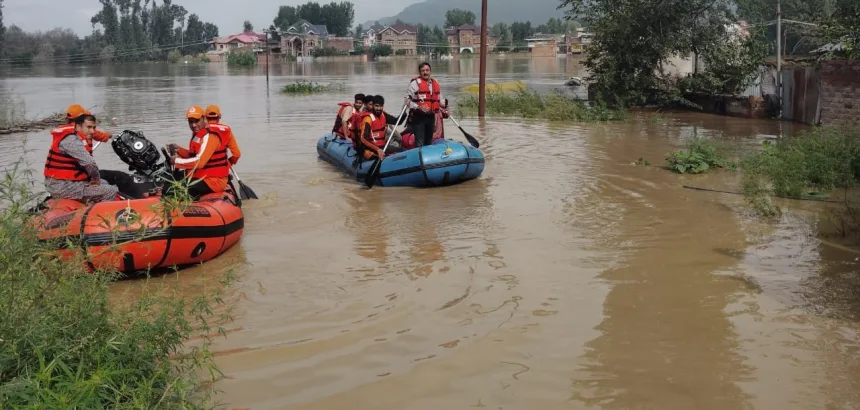Irfan Yattoo & Arif Rashid
Srinagar/Budgam, Sept 4: The flood threat in Kashmir has eased considerably as the Meteorological Department forecast dry weather until mid-September, even as the Jhelum river breached its banks at multiple vulnerable points, leading to widespread evacuations and relief operations. Meanwhile, the Valley remains cut off from the rest of the country after landslides shut all major highways and surface routes for the second consecutive day, stranding over 3,500 vehicles.
Following two days of incessant rainfall, the Jhelum river crossed the danger mark at Sangam (Anantnag) and Pampore on Wednesday before breaching embankments at several locations including Shalina near Srinagar and Zonipora village in Budgam district. Low-lying areas in Srinagar such as Lasjan, Nowgam, Padshahibagh, Mehjoor Nagar, and Vyethpora were inundated, along with parts of Pulwama, Anantnag, Kulgam, and Budgam districts.
In Budgam, a breach near Zonipora led to flooding in Shalina, Rakh Shalina, and Baghi Shakirshah. Over 9,000 people were evacuated overnight as a precautionary measure.
Divisional Commissioner Kashmir said, “Early this morning, breaches occurred in the Jhelum embankments at Zonipora in Budgam, resulting in flooding of nearby areas. However, as a precaution, we had already evacuated around 9,000 people last night, which helped prevent any loss of life.”
He added, “The weather conditions have started to improve, especially in South Kashmir, and most areas are experiencing clear skies. Water levels at Sangam and Ram Munshi Bagh are receding, which is a positive sign.”
Deputy Commissioner Budgam Dr. Bilal Mohiuddin Bhat confirmed, “We have 11 teams from the SDRF and 5 teams from the NDRF engaged in rescuing those trapped by the floods. Our entire workforce and equipment are deployed on the ground to conduct rescue operations in the flood-affected areas.”
Rescue operations are ongoing in Summerbugh, Tangan, and other inundated villages, with residents urged to move to designated relief centres. Six rescue centres have been activated across Budgam at Wagoora, Khandah, BK Pora, Kralpora, and Dangerpora, offering shelter, food, water, electricity, and medical support.
The administration has stocked sufficient fuel and essential commodities, while police and security agencies remain on high alert. Emergency helplines are operational for public assistance.
Contingents from the SDRF, NDRF, police, and Revenue Department are using boats to evacuate families trapped in submerged homes. Vulnerable points along the river in Srinagar’s Barzulla, Gandbal, and Bemina have been fortified with sandbags to prevent further breaches.
Authorities have advised residents to avoid embankments and waterlogged areas and cooperate with ongoing relief efforts.
Director of the Meteorological Department Dr. Mukhtar Ahmad stated, “No major rainfall is expected till mid-September. The Valley will see largely dry weather, though brief showers cannot be ruled out. Jammu may witness short monsoon spells on September 6-7 and again on September 8.”
At 8 PM on Thursday, Jhelum levels had dropped below flood marks at key locations, 24.19 ft at Sangam (danger mark 25 ft), 21.55 ft at Munshi Bagh, and 14.02 ft at Asham. Tributaries including Vishow, Rambiyara, Lidder, and Sindh were also flowing below danger levels.
Meanwhile, the upper reaches of Kashmir witnessed the season’s first snowfall on Wednesday night. Fresh snow was recorded in Pahalgam, Sinthan Top, Peer Ki Gali, Margan Top, and Sonamarg, signaling the onset of colder weather.
Officials cautioned that despite improving conditions, landslides, mudslides, and shooting stones remain a threat in vulnerable areas.
While floodwaters recede, the Kashmir Valley has been isolated from the rest of the country as all major highways and inter-district roads remain shut due to landslides, mudslides, and road washouts triggered by incessant rains.
The Jammu-Srinagar National Highway — the Valley’s only all-weather road — along with Mughal Road, Sinthan Road, Jammu-Rajouri-Poonch highway, and Batote-Doda-Kishtwar highway are closed.
A traffic advisory bans vehicular movement from Jakhani (Udhampur) to Srinagar and vice versa. Over 3,500 vehicles remain stranded between Kathua and Kashmir at various points including Samba, Jammu, Udhampur, Ramban, and Kashmir Valley itself.
Traffic on the Jammu-Rajouri-Poonch highway is halted at Chowki Choura near the Kandi tunnel, stranding more than 400 vehicles. The Batote-Doda-Kishtwar highway is blocked by landslides at Pul Doda, affecting about 200 vehicles. The Kishtwar-Sinthan-Anantnag road and Mughal Road also remain closed.
Officials report significant damage on the Udhampur-Ramban-Banihal stretch, including washed-away retaining walls, collapsed road sections, and a landslide blocking one tube of the Peerah tunnel. Approximately 10 km of road in the Udhampur sector is unusable.
With surface connectivity severed, Kashmir’s only lifelines to the rest of India remain flights operating from Srinagar Airport and the rail line connecting Katra and Srinagar.
Authorities are working on restoration on a “war footing” to reopen highways but warn of continued disruptions due to fresh landslides and falling boulders in several districts.





